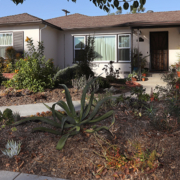Removing grass can generate rebates of at least $2 per square foot for San Diego residents under new enhanced incentives that started this month.
As of April 1, the Metropolitan Water District is offering $2 per square foot for every square foot of grass removed from yards and replaced with sustainable landscaping.
Rebates may vary by water agency, but an online incentive calculator identifies the current rebate amounts.

New rules for turf rebates. Graphic: BeWaterSmart.com
To increase participation, MWD also updated program rules. The rules are listed at the application site.
All San Diego County residents are eligible for the $2 rebate.
But, that’s not all. The San Diego County Water Authority is offering an additional $1.75 per square foot to customers in its service area, with grant funds provided by the California Department of Water Resources. And, the City of San Diego offers city residents $1.25 per square foot. That means some homeowners can earn as much as a $5 rebate for each square foot of turf removed.
Turf rebate programs have proven popular in Southern California, and funds could go quickly.
Water Authority offers free landscaping classes
While rebates can provide a big boost to landscaping makeover projects, it’s also important to start planning before you start planting.
That’s where the Water Authority’s WaterSmart Landscape Makeover Program comes in. Free resources are available to upgrade turf yards.
For instance, the Water Authority offers free landscape makeover classes that help homeowners make smart choices to reduce outdoor water use by designing beautiful and climate-appropriate landscapes for our region.
Find additional water-saving programs, incentives, and classes for residents and businesses at: https://www.watersmartsd.org/
“San Diego County homeowners and businesses know that sustainable landscapes are key to water reliability in our region,” said Joni German, who manages the Water Authority’s WaterSmart Landscape Makeover Program. With the help of local landscape architects and designers, our WaterSmart Landscape Makeover Program gives them the knowledge and skills they need to be successful. WaterSmart landscapes are an upgrade, not a compromise.”




